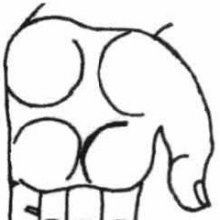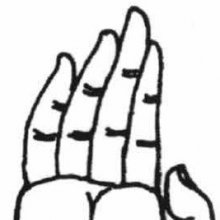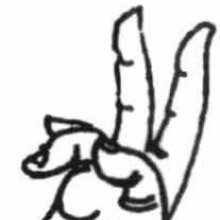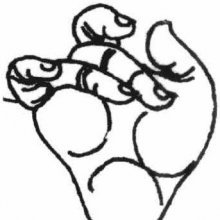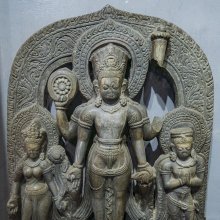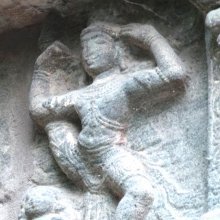Hand gesture, Hand posture: 1 definition
Introduction:
Hand gesture means something in Hinduism, Sanskrit. If you want to know the exact meaning, history, etymology or English translation of this term then check out the descriptions on this page. Add your comment or reference to a book if you want to contribute to this summary article.
Images (photo gallery)
(+1 more images available)
In Hinduism
Natyashastra (theatrics and dramaturgy)
Source: Shodhganga: Elements of Art and Architecture in the Trtiyakhanda of the Visnudharmottarapurana (natya)Hand Gestures (in Indian Dramas) are denoted by the Sanskrit term Hasta or Hastamudrā, according to the Viṣṇudharmottarapurāṇa, an ancient Sanskrit text which (being encyclopedic in nature) deals with a variety of cultural topics such as arts, architecture, music, grammar and astronomy.—The hand postures are termed as hastamudrās in Sanskrit. The hastamudrās are very essential to denote some particular action or state in dancing and these mudrās are formed with the help of hands and fingers. In the Viṣṇudharmottarapurāṇa the necessity of hand gestures are highly recommended as according to this book, Dance depends on the actions of the hands. In the Viṣṇudharmottarapurāṇa mainly three kinds of hastamudrās are discussed and those are termed as hasta.
In the Viṣṇudharmottarapurāṇa mainly three kinds of Hand Gestures (hasta-mudrās) are discussed and those are termed as hasta:—
- asaṃyukta-hasta,
- saṃyukta-hasta and
- nṛtta-hasta.

Natyashastra (नाट्यशास्त्र, nāṭyaśāstra) refers to both the ancient Indian tradition (shastra) of performing arts, (natya—theatrics, drama, dance, music), as well as the name of a Sanskrit work dealing with these subjects. It also teaches the rules for composing Dramatic plays (nataka), construction and performance of Theater, and Poetic works (kavya).
See also (Relevant definitions)
Partial matches: Gesture, Posture, Hand.
Query error!
Full-text (+943): Mudra, Hastamudra, Hasta, Nrittahasta, Anjali, Kartarimukha, Garudapaksha, Tripataka, Alapallava, Mushti, Tarjani, Gaja, Caturahasta, Padmakosha, Pataka, Ardhacandra, Kapitthahasta, Yonimudra, Kapotahasta, Gajadanta.
Relevant text
Search found 45 books and stories containing Hand gesture, Hand gestures, Hand posture, Hand postures; (plurals include: Hand gestures, Hand gestureses, Hand postures, Hand postureses). You can also click to the full overview containing English textual excerpts. Below are direct links for the most relevant articles:
Vishnudharmottara Purana (Art and Architecture) (by Bhagyashree Sarma)
2.2. Hand Postures (a): Asaṃyukta-hasta < [Chapter 3 - Drama and Dance]
2.2. Hand Postures (b): Saṃyukta-hasta < [Chapter 3 - Drama and Dance]
2. The Viṣṇudharmottara-purāṇa and the Indian Classical Dances < [Chapter 6 - Modern Relevance of Different Art Forms and Architecture]
Buddhist iconography in and outside India (Study) (by Purabi Gangopadhyay)
Glossary of Japanese Buddhist terms
Avalokiteshvara vis-a-vis Vishnu, Brahma and Shiva < [Chapter 2: Indian Buddhist Iconography (a Comparative Study)]
Amitabha (Amida) in Japan < [Chapter 4: Japanese Buddhist Iconography (a Comparative Study)]
World Journal of Pharmaceutical Research
Mudras unlocking the healing potential for body and mind < [2023: Volume 12, August issue 13]
Mudra therapy for health during complicated pregnancy bed rest < [2022: Volume 11, March issue 3]
Retrospective study on wrist injuries < [2018: Volume 7, May special issue 10]
Hevajra Tantra (analytical study) (by Seung Ho Nam)
1.5. The Four Energy Centres (cakra) < [Chapter 4 - Tantric Cult in Hevajra Tantra]
1.2. Mantras (used for invoking the Buddhas) < [Chapter 4 - Tantric Cult in Hevajra Tantra]
Natyashastra (English) (by Bharata-muni)
Chapter IX - Gestures of Major Limbs (aṅga)
Part 7 - Data of India’s Cultural History in the Nāṭyaśāstra < [Introduction, part 1]
Part 4 - The Ancient Indian Drama in Practice < [Introduction, part 1]
Gati in Theory and Practice (by Dr. Sujatha Mohan)
Elements of Āṅgika-abhinaya in Nāṭyaśāstra < [Chapter 1 - Nāṭya]
Observations on works on nāṭya in Sanskrit literature < [Chapter 1 - Nāṭya]
Nṛtta as a division of Āṅgika-abhinaya < [Chapter 1 - Nāṭya]
